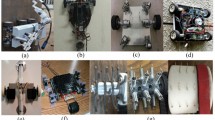Abstract
Legged-climbing robot is considered. Each foot of the robot has an electromagnet system for robot"s holding on a metal surface. This surface can be both vertical and inclined, including negative slope. Analytical calculation of robot stability under turn over or sliding conditions has been made. Critical slopes have been determined. One of these slopes corresponds to minimal reserve of robot stability towards sliding and another to minimal reserve of robot stability towards turning-over. As total reserve of stability of a robot is always equal to the minimal one of these reserves. Additional support elements of elastic material with high coefficient of friction, along with electromagnet, allows to increase minimal reserve of robot stability towards sliding. The use of such support elements leads to redistributing force of normal support reaction between electromagnet (which surface has low coefficient of friction) and additional support element (which surface has high coefficient of friction). It is just what leads to increasing the total friction force and as a consequence to increasing of minimal reserve of robot stability towards sliding.
Similar content being viewed by others
References
Armada, M., González de Santos, P., Prieto, M., and Grieco, J. C.: A six legged climbing robot Euromech, Munich, April 1998.
Grieco, J. C.: Climbing robots: Design, stability and control strategies, PhD Thesis, University of Valladolid, Spain, 1997.
Grieco, J. C., Prieto, M., Armada, M., and Gonzales de Santos, P.: A six legged climbing robot for high payloads, in: IEEE Conf. on Control Applications, Trieste, Italy, September 1998.
Hirose, S.: Wall climbing vehicle using internally balanced magnetic units, in: Proc. of the 6th CISM-IFTOMM Symp. ROMANSY-86, Cracow, 1986.
Ikeda, K. and Nozaki, T.: Development of a self contained wall-climbing robot, in: ISART, 1991.
Prieto, M., Armada, M., and Grieco, J. C.: Experimental issues on wall climbing gait generation for a six legged robot, in: Clawar'98, Brussels, November 1998.
Sato, K., Honda, K., Hasegawa, A., Shiota, T., and Morita, H.: On-wall locomotive vehicle, in: ISART, 1991.
Sugiyama, S., Naitoh, S., Satoh, C., Ozaki, N., and Watahiki, S.: Wall surface vehicles with magnetic legs or vacuum legs, in: Proc. of the 16th ISIR, Brussels, Belgium, 1986.
Author information
Authors and Affiliations
Rights and permissions
About this article
Cite this article
Akinfiev, T., Armada, M., Prieto, M. et al. Concerning a Technique for Increasing Stability of Climbing Robots. Journal of Intelligent and Robotic Systems 27, 195–209 (2000). https://doi.org/10.1023/A:1008158332368
Issue Date:
DOI: https://doi.org/10.1023/A:1008158332368




